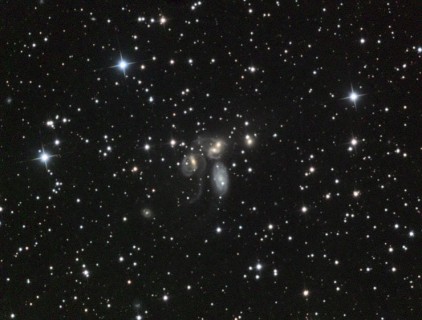2/10/2013 NGC 6992
Greetings Everyone!
After taking a few months break from image processing I decided to jump back into this past weekend.
Since the weather in Seattle isn’t exactly perfect for imaging in February, this latest image was produced from data which I captured September – October, 2012. This particular object is called NGC 6992, otherwise known as the Eastern Veil nebula.
This is my first attempt to capture the veil nebula. It’s quite a large structure, so it isn’t possible to capture the entire object with my scope. The good news is that many sections of the nebula are fantastic and beautiful just on their own, and I do plan to image these other parts of the nebula in 2013.
From the wikipedia artice, “The Veil Nebula is a cloud of heated and ionized gas and dust in the constellation Cygnus. It constitutes the visible portions of the Cygnus Loop (radio source W78, or Sharpless 103), a large but relatively faint supernova remnant. The source supernova exploded some 5,000 to 8,000 years ago, and the remnants have since expanded to cover an area roughly 3 degrees in diameter (about 6 times the diameter, or 36 times the area, of the full moon). The distance to the nebula is not precisely known, but Far Ultraviolet Spectroscopic Explorer (FUSE) data supports a distance of about 1,470 light-years.”
From an image processing standpoint, I have been wanting to make some progress with coming up with better imaging sharpening techniques for quite some time now. Most techniques I’ve tried so far produce halos around stars, and many add a sort of blotchy noise to the resulting image. I have been trying to find something better. After some searching I ran across “Fat Tail” Richardson-Lucy Deconvolution and decided to give it a try. After spending some time learning how to adjust this new tool, I think the results were pretty good.
NGC 6992 is presented here in Hubble palette:
Red = S II (ionized sulfur)
Green = HA (hydrogen alpha)
Blue = O III (doubly ionized oxygen, having two electrons removed)
Here are the technical details:
NGC 6992 – The Eastern Veil Nebula
Capture date: September 19, 2012 – October 5, 2012
LRGB image using Ha+SII+OIII for Luminance, SII for Red, OIII for Blue and Ha for Green
Astrodon filters: 5nm HA, 5nm SII and 3nm OIII
39 exposures of OIII, with 20 minute subs each
24 exposures of SII, with 20 minute subs each
21 exposures of HA, with 20 minute subs each
Imaging scope: Astro-Tech AT10RC Ritchey Chrétien at f/6.7 (native f/8)
Focal reducer: Astro Physics CCDT67 focal reducer
Imaging camera: QSI 583wsg monochrome
Guide camera: Starlight Xpress Lodestar
Mount: Celestron CGE hypertuned by Deep Space Products
Capture and stacking in Maxim DL
All other processing in Photoshop
Over 28 hours of starlight exposures went into this project.









